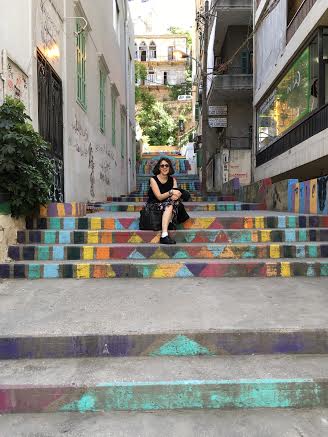Mar Mikhael steps, Beirut
I arrived in Beirut on Friday night, and on Saturday my hosts drove me to the Armenian village of Anjar in the Bekaa Valley, close to the Syrian border. The women of the ABC Book Club had set up a large television set and thirty chairs on a spacious home patio. Members of the book club made short speeches about the history of their group, an introduction to my work, and a brief reading from my second novel, DREAMS OF BREAD AND FIRE, which they had read and discussed. Then I presented my “Armenian Diaspora Quartet” slideshow, weaving in two poems, “The Angel” and “Homage to Bourj Hammoud.” After the presentation, we ate homemade Armenian and Lebanese desserts in the garden. My favorite was a fruitcake called kumba, a specialty of Anjar (made from a recipe the Armenians of Musa Ler had brought with them in the late 30’s). My hosts insisted that I take home the entire platter of kumba. When I asked, “What will I do with all this?” I was told, “It has no eggs or butter; it keeps forever. Eat what you like, and at the end of the week you can put it in your suitcase.” (Believe me, I did it.)
The next evening was April 24th, and I went with friends to the Armenian Genocide vigil in Martyrs’ Square in downtown Beirut. After listening to the speeches for a while, we walked around the soulless ghost town that is the Solidere reconstruction of the old Souk area. The following day when I ventured out on my own—trying to get to the Sursock Museum to see the Assadour show—I got horribly lost. When I had showed the receptionist at the hotel a map, and asked for directions from the hotel to the museum, she looked at the map as though she had little idea of what it was, let alone how to read it. People in Beirut don’t use maps, and the available ones are pretty terrible, so for a person such as myself with absolutely no sense of direction, navigating the city was a challenge. A soldier at an intersection noticed my confusion, asked me where I was going, told me that I was very far from my destination (I had walked for fifteen minutes in the opposite direction), and explained that the only way for me to get there was by taxi.
The rest of the week, volunteer guides—old friends, new friends, and an aspiring fiction writer who is a student at Haigazian University—accompanied me. They were all locals who negotiated the maze of streets without maps. After the first afternoon of walking around in Bourj Hammoud, I despaired of ever being able to properly situate my characters in the space. But by the final day of my trip, I had determined the street where the Serinossians resided, the church they attended, the school where the children were enrolled, the father’s occupation, and his place of work. For later reference, I took photos of old wooden houses, mid-century apartment buildings with balconies and awnings, Armenian schools, Armenian churches, streets signs, and old doors. I also identified a few common birds: laughing dove, house sparrow, rock dove, and white wagtail. In Bourj Hammoud and Nor Hadjin I saw canaries in wire cages and zebra finches in wooden ones.
Equally importantly, I heard stories of the war years—the kinds of anecdotes that provide me with the small details I need to create the narrative world of the novel. Here is one line I heard that opened up a universe of feeling: “Sundays were sad days—because the ships took them to Cyprus, and from there they flew away.”
Nancy Kricorian
New York City
May 13, 2016
